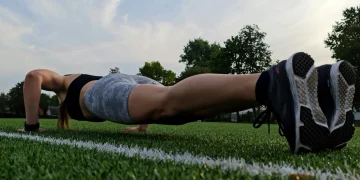This guide is for those who want to know how to get into running and, more importantly, not quit. We have collected answers to beginners’ questions about running and recommendations for training.
How to Choose a Goal in a Running Plan for Beginners?
If it is difficult to start running and choose a goal, try this psychological trick: decide to follow a training program for a week/month. Having made this decision, follow it without hesitation before each workout.
Sign up for a race. You can start with five kilometers. Running events are a special atmosphere and a good motivator to stay on your training program.
Running programs provide more than just the ability to burn calories and expend energy. You’ll feel stronger and more resilient, a form of active meditation.
“A process-driven running life is the first step to being a happy runner long term. Because you are enough, every day, no matter what,” says David Roche, author of The Happy Runner: Love the Process, Get Faster, Run Longer.
By the way, there is no correct goal – goals are different for everyone, and understanding and accepting that is important.
- The goal should start with understanding what shape you are in.
- Even a month of regular training for beginners will be a big achievement – this is an excellent first goal.
- If you need a “distance” as your goal, we recommend choosing a beginner 5k training plan. The standard 5K training plan is 8 weeks. Don’t forget about the individual characteristics of your body. It may take only 4 weeks for you to prepare.
- There is no “normal time” concept for the first race if you have never trained before. This is an individual parameter.
Move towards the goal gradually, and do not scold yourself for missed workouts. We are all human beings.
Consult with the coach for a 5k training plan that is most optimal based on your performance.
How to Start Running for Beginners
Everybody should undergo a basic health check and take basic tests at least once a year. However, checking your health becomes more acute if you regularly and purposefully go for sports.
You can understand the current state of your body and potential risks. Then you can start a beginner running plan.
Following your goal, you need to draw up a plan for how to start running. The fact is that beginners running “by intuition” often give themselves an excessive load and get injured.
This is because the cardiovascular system develops faster than the ligamentous apparatus and muscles. So it feels easier to run, and the person increases the load disproportionately. As a result, injury occurs.
The best way to get a plan is to go to a professional trainer. Make sure the coach makes individual plans and doesn’t give all beginners the same template.
Another good option is to join a training group. It is easier to maintain motivation, but there is no individual approach, and there is a risk of getting a load below or above the optimal one.
Even easier is downloading a standardized plan on a running app or joining an online beginner stream. This gives you more freedom of action (no need to come to group training) and costs less than other options. Ideally, in such a course, there will be an opportunity to ask questions to the coach and receive their advice. You can download the beginner marathon training plan for that purpose.
The 5k Training Plan for Beginners
Smart goals work effectively in sports. You can narrow your goal to minutes and set a race date using a project approach: treating your training and preparation for your first 5 kilometers race as a project.
The 5k training plan for beginners consists of cross-training, speed intervals, and rest days to recharge your body. Training should be done no more than 3-4 times a week with 30 to 45 minutes of running in each session. The duration of the main training sessions indoors and on the ground is 1-1.5 hours, on track 50-70 minutes. This includes warming up, stretching, resting, and consulting with a coach.
Example for the 1st week of the running schedule.
Monday: Morning running for 5 minutes, walking for 1 minute. Repeat 3 times.
Tuesday: Resting or cross-training.
Wednesday: Running for 6 minutes, walking for 1 minute. Repeat 3 times.
Thursday: Rest day.
Friday: Running for 7 minutes, walking for 1 minute. Repeat 3 times.
Saturday: Resting or cross-training.
Sunday: Rest day.
Now you know how often beginners should run. With proper motivation, all is possible.
“The advice I have for beginners is the same philosophy that I have for runners of all levels of experience and ability: consistency, a sane approach, moderation, and making your running an enjoyable, rather than dreaded, part of your life,” says Bill Rodgers, 4-time Boston Marathon winner.
Preparing to overcome your first and relatively short distance requires a good mental attitude and clear motivation. Having overcome the five-kilometer barrier, most beginners understand that all obstacles are just in their heads and soon begin to prepare to conquer more serious peaks.
Running Tips for Beginners
Before running, stretching the body is advisable to warm up the muscles and joints.
This can be done in several ways:
- Self-massage or with a foam roller. By massaging the muscles, we improve blood circulation. It is more convenient to use a roller, but this procedure can be painful;
- Joint workout. Circular movements with the joints: ankles, knees, hips, pelvis, shoulders, and neck;
- Light exercises for general physical fitness for 5-10 minutes.
Walking, jogging, or very light running for the first 10-15 minutes of your workout is also a warm-up.
Difficult parts of the running routine, such as speeding up, can be started once you are warm and start to sweat a little.
Correct, natural running consists of three phases:
- runner’s position (the heel of one leg is pulled up to the buttock, the knee of the supporting leg is slightly bent);
- the fall;
- pulling the leg to the pelvis.
The center of gravity is in the hips, the back is flat, the knees are slightly bent, and the gaze is forward, not down.
When “pulling up,” the heel goes to the buttock, and the landing occurs without additional effort: the leg itself falls to the ground exactly under the pelvis.
Beginners tend to make a number of common mistakes in the running routine. It is better to know about them in advance and avoid them. For example, running too fast or too much and a lack of rest days lead to overtraining, injury, and burnout.
The best way to learn how to run correctly is to contact a coach. Moreover, it will probably take several sessions to feel the progress in the running.
Wrap Up
In summary, this is our guide to start running for beginners. And here are our key rules for anyone about to begin their running journey.
- You need to train regularly, but taking rest days between workouts: three workouts a week are enough to start.
- The load must be increased gradually.
- It is advisable to combine strength training and general physical training with running.
Remember, like any activity, running must be performed systematically and regularly. Therefore, the main thing is not to give up training. Keep moving forward, and the result will not keep you waiting!






